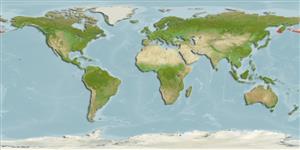Elasmobranchii (sharks and rays) >
Rajiformes (Skates and rays) >
Arhynchobatidae (Skates)
Etymology: Bathyraja: Greek, bathys = deep + Latin, raja, -ae = a ray (Raja sp) (Ref. 45335); maculata: Name from the Latin adjective 'maculata' meaning blotched, referring to the color markings on the dorsal side of the disc.
Environment / Climate / Range
Ecology
Marine; bathydemersal; depth range 70 - 1193 m (Ref. 50610). Deep-water, preferred ?; 59°N - 51°N
Northwest Pacific: known from the type locality, the Bering Sea.
Length at first maturity / Size / Weight / Age
Maturity: Lm ?, range 94 - 101 cm
Max length : 115 cm TL male/unsexed; (Ref. 56527); max. published weight: 8.5 kg (Ref. 56527)
Short description
Morphology | Morphometrics
This species is distinguished from its congeners Bathyraja in having a white blotches of different sizes on the dorsal surface of the disk, lateral folds of tail are broad; clasper has a large pseudosiphon; dense silky fibers covering egg capsule (Ref. 75535).
Holotype taken from a depth of about 450 m (Ref. 26282). Maximum depth based on report for Bering Sea and Aleutian Islands (Ref. 80796). Oviparous. Distinct pairing with embrace. Young may tend to follow large objects, such as their mother (Ref. 205). Eggs are oblong capsules with stiff pointed horns at the corners deposited in sandy or muddy flats (Ref. 205). Egg capsules are 10.19 cm long and 6.28 cm wide (Ref. 41249).
Life cycle and mating behavior
Maturity | Reproduction | Spawning | Eggs | Fecundity | Larvae
Oviparous, paired eggs are laid. Embryos feed solely on yolk (Ref. 50449). Distinct pairing with embrace. Young may tend to follow large objects, such as their mother (Ref. 205).
McEachran, J.D. and K.A. Dunn, 1998. Phylogenetic analysis of skates, a morphologically conservative clade of elasmobranchs (Chondrichthyes: Rajidae). Copeia 1998(2):271-290. (Ref. 27314)
IUCN Red List Status (Ref. 115185)
CITES (Ref. 94142)
Not Evaluated
Threat to humans
Harmless
Human uses
More information
ReferencesAquacultureAquaculture profileStrainsGeneticsAllele frequenciesHeritabilityDiseasesProcessingMass conversion
Tools
Special reports
Download XML
Internet sources
